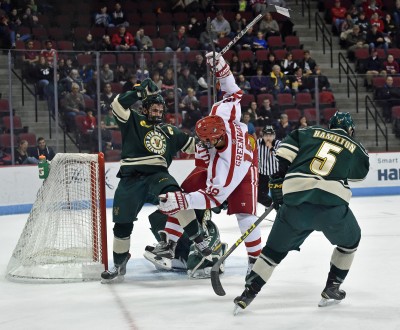
The NCAA’s 2016 Division I Men’s Hockey Championship is down to its final four teams, and with the excitement building as to who this year’s national champion will be, some schools feel hard done by the selection committee omitting them from contention.
Robert Morris University topped the standings in Atlantic Hockey from start to finish this season, but it failed to qualify for the NCAAs because of a weak schedule. This happened despite the fact it had one of the top scoring offenses in the country, a dominant power play and truly earned a bid.
Michigan Technological University, out of the Western Collegiate Hockey Association, lost just nine games this season and won its conference regular season title. The only downside was that one of those nine games was its conference tournament semifinal game to eventual champion Ferris State University.
The University of Minnesota shocked the entire nation by outright winning the Big Ten over the conference-favorite University of Michigan. In the tournament final, the Golden Gophers were defeated and subsequently eliminated from postseason contention.
All these schools feel that they should be rewarded for their efforts rather than just thriving in the conference tournament and winning a couple games down the stretch.
This begs the question — should the postseason tournament expand to 24 teams? And the answer is a resounding yes.
There are currently 60 Division I teams in the NCAA, yet only 16 make the tournament. That’s just over 26 percent of the nation’s teams. While a NCAA bid is exclusive, more programs should be represented.
To put this in perspective, men’s college basketball has a 68-team tournament, and with 351 Division I programs, that amounts to nearly 20 percent of teams getting into the big dance.
However, include the 80 other teams that qualify for three lesser-known postseason tournaments, and just over 42 percent of teams get the chance to extend their season.
In professional sports, the same issue often occurs. Teams play a tremendous season, earn a regular-season conference crown and then get knocked out by a bottom seed that happened to get hot at the right time. While this is far more rare, it still happens.
However, the playoffs are much easier to reach in professional sports. For example, the NHL and NBA each have 30 teams. With 16 teams making the playoffs in both, more than half of the franchises earn the chance to vie for the Stanley Cup or the Larry O’Brien NBA Championship Trophy.
But back to NCAA hockey. Adding eight teams to a previously expanded postseason field would complicate things, right? Like, this could add weeks to the season and mess up everyone’s schedule, right? Nope, wrong.
There are nearly two weeks between the regional round and the Frozen Four. As to why this is necessary, nobody knows. But this provides an opportunity to expand the tournament.
Other notable teams missing this year’s tournament that deserved to qualify include Minnesota State University, Mankato and Cornell University, both of which are defensive juggernauts that fell in their conference tournaments. Pennsylvania State University was also on the bubble all season long, but barely missed out with a 21-13-4 record.
These teams all had winning records and deserved to be playing playoff hockey. But with just 16 teams making it, programs such as Penn State fail to get noticed for their accomplishments.
So how would this expansion plan work, you ask? Well, 24 teams means there are six teams per region instead of four, thus creating an uneven number for brackets. This is where top teams get rewarded along with the bubble teams. The top two seeds get byes, while three through six play at the home site of the three-seed or a more suitable facility nearby.
Before you say a bye system will never work, it actually did for a long time. However, moving from 12 to 16 teams eliminated the need for it. So rather than playing the round of 16 during the final weekend in March, the round of 24 would be underway at the site of the third seed.
The following weekend, teams that survived the round of 24 would head into the round of 16 with the teams receiving byes at the normal regional sites. This would then replace the bye week prior to the Frozen Four.
This second weekend along with the weekend of the Frozen Four would both happen as they usually do now, with the exception of a week off in between.
You see, it’s a rather simple solution to a general problem in college hockey. Not only does it give more schools an opportunity to compete at the national level as a reward for their efforts over a full season, but it also makes the tournament a lot more interesting. And not to mention — it’s very practical and not terribly outrageous.




















































































































